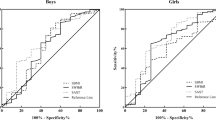Abstract
Skinfold thickness is an indicator of body fat, allowing a more detailed description of obesity. In Vietnam, there are no published percentile values for triceps and subscapular skinfold measurements from population-based studies of adolescents. This study aims to establish percentile tables for triceps, subscapular, and triceps + subscapular skinfolds (TSF + SSSF) sum. We used data from a cross-sectional survey conducted in Ho Chi Minh City. BMI, triceps and subscapular skinfold measurements of 2660 students were obtained. The L (Box-Cox transformation), M (median), and S (coefficient of variation) parameters were used to generate exact percentiles. The proportion of overweight was higher in boys (18.4% vs. 8.2%, p < 0.0001). Triceps, subscapular skinfolds, and TSF + SSSF were significantly higher in girls than in boys (p < 0.001). Our results provide sex- and age-specific reference values for skinfold thickness that can be applied as a new complimentary assessment tool for Vietnamese adolescents.
This is a preview of subscription content, access via your institution
Access options
Subscribe to this journal
Receive 12 print issues and online access
$259.00 per year
only $21.58 per issue
Buy this article
- Purchase on Springer Link
- Instant access to full article PDF
Prices may be subject to local taxes which are calculated during checkout
Similar content being viewed by others
References
Hong TK, Trang NH, Dibley MJ. Changes in adiposity indicators of Ho Chi Minh City adolescents in a 5-year prospective cohort study. Int J Obes. 2013;37:1261–7.
Nguyen PV, Hong TK, Hoang T, Nguyen DT, Robert AR. High prevalence of overweight among adolescents in Ho Chi Minh City, Vietnam. BMC Public Health. 2013;13:141.
China’s National Group On Students C, Health S. Study on the measurement of skinfold thickness and estimation of body composition in Chinese primary and secondary school students. Zhonghua Yu Fang Yi Xue Za Zhi. 2000;34:212–4.
Cicek B, Ozturk A, Unalan D, Bayat M, Mazicioglu MM, Kurtoglu S. Four-site skinfolds and body fat percentage references in 6-to-17-year old Turkish children and adolescents. JPMA J Pak Med Assoc. 2014;64:1154–61.
Ramirez-Velez R, Lopez-Cifuentes MF, Correa-Bautista JE, Gonzalez-Ruiz K, Gonzalez-Jimenez E, Cordoba-Rodriguez DP. et al. Triceps and subscapular skinfold thickness percentiles and cut-offs for overweight and obesity in a population-based sample of Schoolchildren and Adolescents in Bogota, Colombia. Nutrients. 2016;8:595.
Marrodan MD, Gonzalez-Montero de Espinosa M, Herraez A, Alfaro EL, Bejarano IF, Carmenate M, et al. Development of subcutaneous fat in Spanish and Latin American children and adolescents: reference values for biceps, triceps, subscapular and suprailiac skinfolds. Homo: Int Z fur die Vgl Forsch am Menschen. 2017;68:145–55.
Tang KH, Nguyen HH, Dibley MJ, Sibbritt DW, Phan NT, Tran TM. Factors associated with adolescent overweight/obesity in Ho Chi Minh city. Int J Pediatr Obes. 2010;5:396–403.
Cole TJ, Bellizzi MC, Flegal KM, Dietz WH. Establishing a standard definition for child overweight and obesity worldwide: international survey. BMJ. 2000;320:1240–3.
WHO Expert Committee. Physical status: The use and interpretation of anthropometry: report of a WHO expert committee (WHO Technical Report Series; 854). Geneva: World Health Organization; 1995. p. 454.
Gupta N, Misra A, Goel K, Shah P. Childhood obesity in developing countries: epidemiology, determinants, and prevention. Endocr Rev. 2012;33:48–70.
Author information
Authors and Affiliations
Corresponding author
Ethics declarations
Conflict of interest
The authors declare that they have no conflict of interest.
Additional information
Publisher’s note Springer Nature remains neutral with regard to jurisdictional claims in published maps and institutional affiliations.
Rights and permissions
About this article
Cite this article
Tang, H.K., Bowe, S.J., Nguyen, T.H.H.D. et al. Triceps and subscapular skinfold thickness percentiles of a school-based sample of adolescents in Ho Chi Minh City, Vietnam. Eur J Clin Nutr 74, 1483–1487 (2020). https://doi.org/10.1038/s41430-020-0626-3
Received:
Revised:
Accepted:
Published:
Issue Date:
DOI: https://doi.org/10.1038/s41430-020-0626-3
This article is cited by
-
Prevalence, determinants, intervention strategies and current gaps in addressing childhood malnutrition in Vietnam: a systematic review
BMC Public Health (2024)
-
Equations based on anthropometric measurements for adipose tissue, body fat, or body density prediction in children and adolescents: a scoping review
Eating and Weight Disorders - Studies on Anorexia, Bulimia and Obesity (2022)



